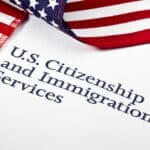Contents
- 1. Who is Eligible?
- 2. The Form
- 3. The Cost
- 4. How Long Does It Take?
- 5. What Comes After?
- 6. What Evidence is Required for the EB-1A Visa: “Persons with Extraordinary ability?
- 7. What evidence is Required for the EB-1B Visa: “Outstanding Professors and Researchers”
- 9. What evidence is Required for the EB-1C Visa: “Multinational Managers and Executives”
- 9. What if you are Outside the United States?
- 10. An Immigration Attorney can be a Great Asset
Navigating the immigration system of the United States can be a challenging and emotionally draining experience. Between the documentation, paperwork, dozens of categories of visa, and the uncertainty of the process it can be overwhelming to someone trying to do it on their own.
But do not fear! Whether you are working with an immigration attorney or doing your own research, we’ve put together TEN important things to learn about the Employment Based First Preference Green Card application!
1. Who is Eligible?
The EB1 Green Card has three subcategories: EB1A for outstanding professors and researchers, EB1B for individuals who have made extraordinary contributions in their field, and EB1C for multinational executives and managers.
To quote the USCIS directly, “You may be eligible for an employment-based, first-preference visa if you are a noncitizen of extraordinary ability, are an outstanding professor or researcher, or are a certain multinational executive or manager. Each occupational category has certain requirements that must be met”.
The first preference listed is a little vague, but to clarify extraordinary ability, they mean “You must be able to demonstrate extraordinary ability in the sciences, arts, education, business, or athletics through sustained national or international acclaim.”
2. The Form
For those who meet the qualifications for “extraordinary ability”, they may fill out a Form I-140, Petition for Alien Worker. But for outstanding professors, researchers, as well as multinational executives and managers, the company or institution must fill out the Form I-140 Petition for them.
In the case of the I-140 petition being approved, your spouse and unmarried children under the age of 21 may be able to qualify for entry in the United States with E-14 or E-15 immigrant status!
3. The Cost
If you are applying within the United States, the base cost for processing a Form I-140 is a $700 filing fee, though if applying as part of an institution or business this fee can be paid by your employer. There is also an $85 biometrics fee.
If you are filing outside of the United States, you will need to complete a DS-260 online immigrant application. This fee will cost $230 plus an $88 fee for the Affidavit of Support.
4. How Long Does It Take?
Naturally, processing the EB-1 Application will vary depending on where you are filing, and the number of applicants for the visa. One of the best things about the EB-1 Green card is that its application bypasses the PERM process, also known as “permanent labor certification program”, which often contributes significantly to the time the process takes.
When you file your I-140 form, that filing serves as the start of the clock known as your “priority date”. Each month, the State Department releases their visa bulletin that provides the “final action dates” for the month, and if those final action dates match your priority date, then a visa number will be made available and you’ll be able to progress to the final stages.
The average time it takes to process the I-140 varies depending on which category of EB-1 visa you’re applying for. For an EB-1A, the process can take as little as six months. For the EB-1B and EB-1C, the process can take between 6 months and two years if all documentation and evidence of requirements is properly met. The USCIS also has an option for expediting the process for extra cost.
5. What Comes After?
Once your I-140 has been approved, you’re almost done! But to complete your process, you need to file a I-485 Application to Register Permanent Resident or Adjust Status. Once you’ve completed that application and it’s approved by the UCSIS, you’ll officially be a legal permanent resident of the United States!
6. What Evidence is Required for the EB-1A Visa: “Persons with Extraordinary ability?
To qualify for the EB-1A, you need to provide evidence of your “extraordinary ability” by matching three of ten criteria listed by the USCIS. The first is evidence of receipt of lesser nationally or internationally recognized prizes or awards for excellence. Proving membership in associations affiliated with your claimed field of excellence is another.
Published materials about you in professional or major trade publications or major media, judging the work of others, original contributions to the field of excellence you are claiming, and authorship of scholarly articles in major media outlets are also things that can be used as evidence for qualification.
Further, you may provide evidence of artistic expressions being displayed at exhibitions or showcases, or performances. Demonstrating that you have played a critical role in distinguished organizations also will be valid for your application. Evidence of a high salary or commercial successes in the performing arts are also metrics which can help you qualify.
7. What evidence is Required for the EB-1B Visa: “Outstanding Professors and Researchers”
You must meet at least 2 out of 6 criteria to qualify, and provide an offer of employment from the prospective U.S. employer. The private employer must show documented accomplishments and that it employs at least 3 full-time researchers. The criteria you must match two of are: Evidence of receipt of major prizes or awards for outstanding achievement, or evidence of membership in associations that require their members to demonstrate outstanding achievement.
Also, evidence of published material in professional publications written by others about the applicant’s work in the academic field or judging the work of others in the same academic field, or evidence of original scholarly or scientific research contributions in the field cited. And of course, evidence of authorship of scholarly books or articles (in scholarly journals with international circulation) in the field.
9. What evidence is Required for the EB-1C Visa: “Multinational Managers and Executives”
To qualify for this category, quoting the UCSIS, you must demonstrate that “Your petitioning employer must be a U.S. employer and intend to employ you in a managerial or executive capacity. The petitioner must have been doing business in the U.S. for at least 1 year, as a legal entity with a qualifying relationship to the entity that employed you abroad in a managerial or executive capacity.”
9. What if you are Outside the United States?
If you’re not in the US when filing your application for an EB-1 Green Card, you’ll need to work through processing it at a US Consulate or Embassy. You’ll start by making at appointment at the Consulate or Embassy for an interview. You’ll need to complete the DS-260 online immigrant visa application and present the confirmation to the Consular officer at the interview.
The timeline for that interview will vary from place to place, with the expected wait to be anywhere between a few weeks to several months. During your interview, you will be asked a variety of questions about your career, experience, education, and the work you’re planning to do in the US so that the Consular officer may judge whether your application qualifies for the program.
10. An Immigration Attorney can be a Great Asset
When navigating through the paperwork required, assembling the evidence necessary, and filing the appropriate documents, an Immigration Attorney can be an invaluable ally helping you through the process. Making sure that everything is correct as its being submitted to the US immigration system will save you a great deal of time and stress.
A good attorney has the best odds of streamlining the process for you and helping you understand it at each stage. Big changes can be difficult, but they don’t need to be insurmountable when you hire the right people to help guide and protect you on your journey.






